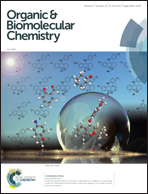New selenosteroids as antiproliferative agents†
Abstract
Starting from natural steroids (diosgenin, hecogenin, smilagenin, estrone), we have prepared a wide panel of selenoderivatives, including benzoselenazolones, selenosemicarbazones, isoselenocyanates, selenoureas, selenocyanates and diselenides, with the aim of developing new families of potential chemotherapeutic agents. The modification of the organoselenium moieties, and their position on the steroid provided valuable information concerning the antiproliferative activities. Among all the families accessed herein, the best profile was achieved for selenoureas on the A ring of estrone, which exhibited GI50 values in the range 2.0–4.1 μM for all the tested tumor cell lines, with increased potency compared with commonly used chemotherapeutic agents, like 5-fluorouracil and cisplatin. Cell cycle analysis revealed that selenoureas induced accumulation of cells in the G1 phase of the cell cycle in the breast cancer cell lines HBL-100 and T-47D; therefore, a different mechanism than cisplatin, that induces cell cycle accumulation in the S phase as a result of DNA damage, must be involved. In the rest of the tumor cells, a slight increase of the S compartment was observed. Moreover, selenosteoids turned out to be excellent glutathione peroxidase (GPx) mimics for the catalytic removal of deleterious H2O2 (t1/2 8.0–22.5 min) and alkyl peroxides (t1/2 23.0–38.9 min) when used in substoichiometric amounts (1% molar ratio), thus providing a valuable tool for reducing the intrinsic oxidative stress in tumor progression.



 Please wait while we load your content...
Please wait while we load your content...